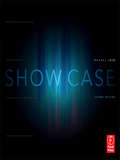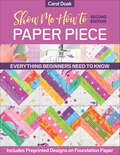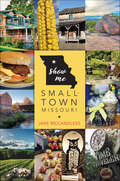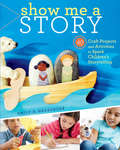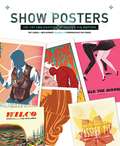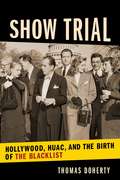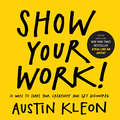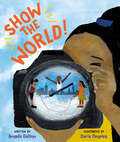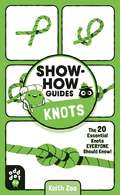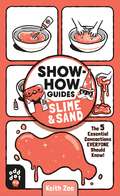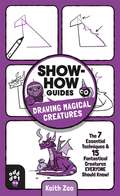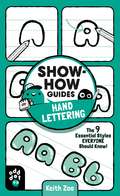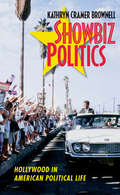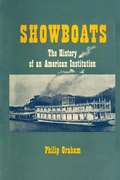- Table View
- List View
Show Case: A Guide to Developing, Maintaining, and Presenting a Design-Tech Portfolio for Theatre and Allied Fields
by Rafael JaenYour theatrical portfolio will earn a standing ovation with guidance from this industry expert!
Show It Off!: Scrapbook Pages And Projects To Display
by Memory Makers EditorsPut Your Talent on Display!Don't hide all your creativity in albums. Show it off! Go beyond the boundaries of your scrapbook pages and pull out all the dimensional stops. All it takes is some inspiration, your stash of supplies and an empty place on the mantle.Show it off! gives you the tools for putting your creativity on display. Each chapter provides tons of project ideas like collage frames, clocks, shadow boxes, mini albums, boxes and photo cubes. Comparisons of the same projects - in layout and display format - illustrate what makes a project great for display. Plus, many of the projects are popular album sizes, letting you easily adapt the ideas to create traditional layouts.With Show it off!, you get everything you need to take your projects out of the album and into real life.Over 120 project ideas, many in popular album sizesStep-by-step instructions and photosTips for creating dimension, binding mini albums, choosing frames and moreComplete supply lists for every piece of artGet ready to turn flat into fabulous. It's time to break out of the album and Show it off!
Show Me How to Paper Piece: Everything Beginners Need to Know; Includes Preprinted Designs on Foundation Paper
by Carol DoakMaster the patchwork sewing technique with tips and tricks from Quilter's Newsletter Magazine's “Favorite Paper-Piecing Teacher.”Learn the basics of paper-piecing with renowned teacher Carol Doak. Beginners can leap into quilting and create their first paper-pieced quilt with thorough instructions and guided visuals to help achieve a perfect, accurate block. Create your own wall quilt by sewing blocks that can be completed in three simple steps! Even first-time quilters can achieve accurate blocks with step-by-step instructions and guidance from expert quilter and bestselling author Carol Doak. Easy for all skill levels!
Show Me Small-Town Missouri
by Jake McCandlessWhere was Mark Twain born? What city has claim to a president who was only president for a day? Who has the best paddling trips in the Ozarks? What about the World's Largest Gift Store? Find these answers and more in Show Me Small-Town Missouri. Award-winning author Jake McCandless, a lover of small towns and adventures, traveled the state in search of amazing local experiences to share this treasure trove of what you can find in often-overlooked towns across Missouri. Featured are 90 sparkling gems found in all four of the state's geographical regions—the Northern Prairie, the Southwest Osage Plain, the Ozarks, and the Bootheel Lowlands. The must-see attractions, activities, restaurants, sweet shops, specialty shops, and unique vacation spots are showcased in full-color images with an easy-to-follow index to help you plan your trip.From galleries to hiking trails, candy factories to wineries, lakeside attractions to the best fireworks displays, Show Me Small-Town Missouri has everything you need to know for a day, weekend, or week full of fun.
Show Me a Story: 40 Craft Projects and Activities to Spark Children's Storytelling
by Emily K. NeuburgerEncouraging children to let their imagination run wild, Emily K. Neubinger offers 40 inventive projects and activities that will inspire kids ages 5 to 12 to express themselves through storytelling. Younger children will love making story stones and a storytelling jar, while older kids will open up and thrive as they embark on guided story walks and inspiring journaling exercises. Sparking creativity while developing a child’s love of language, Show Me a Story will kindle a lifelong passion for both writing and telling original stories.
Show Me the Funny!: At the Writers' Table with Hollywoods Top Comedy Writers
by Jeffrey Davis Peter DesbergEnjoy a unique glimpse into the intelligent and quirky inner workings of the comedic mind! This special e-version of Show Me the Funny! presents 28 top comedy screenwriters--including three bonus interviews not in the original print book--from the revered figures of televisions “Golden Age” to todays favorite movie jokesters. Authors Desberg and Davis put an innovative spin on the traditional interview: each writer was given the same loosely structured comedic premise and asked to develop it in any way he or she wanted-no rules, no boundaries, no limits! The result is a hilarious and illuminating look at the comic process. INCLUDES:o Leonard Stern (co-creator of Get Smart) o Sherwood Schwartz (Gilligans Island, The Brady Bunch) o Peter Casey (co-creator of The Jeffersons, Cheers, Wings, Frasier) o Phil Rosenthal (co-creator of Everybody Loves Raymond) o Ed Decter (co-writer of Theres Something About Mary) o plus three e-book only interviews: Marley Simms (Home Improvement, Sabrina the Teenage Witch)Dan O’Shannon (Modern Family, Frasier, Cheers), and Charlie Hauck (Maude, Cheers)
Show Me, Don't Tell Me
by Dave HolstonA guide to strategic communication for stronger brands!Powerful brands succeed because of the quality of the long-term relationships they establish with customers and stakeholders. At their foundation, these relationships are built upon consistent and meaningful strategic communications. These communications are developed around a framework that defines business goals, considers the audience's needs, surveys the competitive environment, identifies a unique value proposition and establishes a metric for success. Strategic communications are also integrated, bringing together marketing, public relations and internal communications. They are accountable through measurement, and they are accountable to their stakeholders, the various publics and their customers.In this book, author David Holston takes the daunting task of smart communication and makes it manageable in just four steps. Holston has worked in the areas of marketing, advertising, communication planning, design management and public affairs for leading organizations for the past 25 years. He is also a national speaker and the author of two additional books, The Strategic Designer: Tools and Techniques for Managing the Design Process and Design for Online Engagement: SEO, Content and Design Optimization for Editors and Designers.This indispensable guide provides you with a process for developing visual strategic communications that are sure to help your brands succeed.
Show Me, Don't Tell Me: Visualizing Communication Strategy
by Dave HolstonA guide to strategic communication for stronger brands!Powerful brands succeed because of the quality of the long-term relationships they establish with customers and stakeholders. At their foundation, these relationships are built upon consistent and meaningful strategic communications. These communications are developed around a framework that defines business goals, considers the audience's needs, surveys the competitive environment, identifies a unique value proposition and establishes a metric for success. Strategic communications are also integrated, bringing together marketing, public relations and internal communications. They are accountable through measurement, and they are accountable to their stakeholders, the various publics and their customers.In this book, author David Holston takes the daunting task of smart communication and makes it manageable in just four steps. Holston has worked in the areas of marketing, advertising, communication planning, design management and public affairs for leading organizations for the past 25 years. He is also a national speaker and the author of two additional books, The Strategic Designer: Tools and Techniques for Managing the Design Process and Design for Online Engagement: SEO, Content and Design Optimization for Editors and Designers.This indispensable guide provides you with a process for developing visual strategic communications that are sure to help your brands succeed.
Show Posters: The Art and Practice of Making Gig Posters
by Pat Jones Ben NuneryDesign meets music in a one-of-a-kind tour! Powerhouse Factories takes you beyond album covers to teach you all about the art that drives today's biggest shows and festivals. Show Posters offers a visual timeline of the big players in the music industry, from The Black Keys and Passion Pit to Phantogram and Real Estate, as well as the posters that launched their shows--and the designers' careers.Show Posters features step-by-step instructions to guide you through screen printing, hand lettering, and yes, even Xeroxing your way to recreating iconic, kickass posters. The high-energy rock-and-roll artists of Powerhouse Factories will coach you on how to hook up with bands, managers, and promoters, and create an original, limited poster for one of their shows.
Show Trial: Hollywood, HUAC, and the Birth of the Blacklist (Film and Culture Series)
by Thomas DohertyIn 1947, the Cold War came to Hollywood. Over nine tumultuous days in October, the House Un-American Activities Committee held a notorious round of hearings into alleged Communist subversion in the movie industry. The blowback was profound: the major studios pledged to never again employ a known Communist or unrepentant fellow traveler. The declaration marked the onset of the blacklist era, a time when political allegiances, real or suspected, determined employment opportunities in the entertainment industry. Hundreds of artists were shown the door—or had it shut in their faces.In Show Trial, Thomas Doherty takes us behind the scenes at the first full-on media-political spectacle of the postwar era. He details the theatrical elements of a proceeding that bridged the realms of entertainment and politics, a courtroom drama starring glamorous actors, colorful moguls, on-the-make congressmen, high-priced lawyers, single-minded investigators, and recalcitrant screenwriters, all recorded by newsreel cameras and broadcast over radio. Doherty tells the story of the Hollywood Ten and the other witnesses, friendly and unfriendly, who testified, and chronicles the implementation of the postwar blacklist. Show Trial is a rich, character-driven inquiry into how the HUAC hearings ignited the anti-Communist crackdown in Hollywood, providing a gripping cultural history of one of the most transformative events of the postwar era.
Show Your Work!: 10 Ways to Share Your Creativity and Get Discovered (Austin Kleon)
by Austin KleonIn his New York Times bestseller Steal Like an Artist, Austin Kleon showed readers how to unlock their creativity by “stealing” from the community of other movers and shakers. Now, in an even more forward-thinking and necessary book, he shows how to take that critical next step on a creative journey—getting known. Show Your Work! is about why generosity trumps genius. It’s about getting findable, about using the network instead of wasting time “networking.” It’s not self-promotion, it’s self-discovery—let others into your process, then let them steal from you. Filled with illustrations, quotes, stories, and examples, Show Your Work! offers ten transformative rules for being open, generous, brave, productive. In chapters such as You Don’t Have to Be a Genius; Share Something Small Every Day; and Stick Around, Kleon creates a user’s manual for embracing the communal nature of creativity— what he calls the “ecology of talent.” From broader life lessons about work (you can’t find your voice if you don’t use it) to the etiquette of sharing—and the dangers of oversharing—to the practicalities of Internet life (build a good domain name; give credit when credit is due), it’s an inspiring manifesto for succeeding as any kind of artist or entrepreneur in the digital age.
Show the World!
by Angela DaltonA celebration of self-expression and the power of using your voice, centering Black children, and exploring the many things they can do, create, and say to make their mark.Look around! Can you see?The many spaces, places, and ways toshow the world all that you can be? From painting, music, and slam poetry, to engineering, protesting, and photography, a young narrator journeys through her neighborhood, encouraging readers to explore all the many ways they can express themselves. A gorgeously illustrated and powerful celebration of self-expression shows children that there are so many spaces and opportunities to use their voices—and show the world exactly who they are. What will you show the world?&“Thoughtful and inquisitory…Show kids the world is their oyster by giving them this thought-provoking book.&”—Kirkus Reviews &“Dalton&’s encouraging prose and Peoples' vivid illustrations will inspire young readers to explore various modes of self-expression and find an outlet to help them be themselves and also learn more about their community and the world. Readers of all ages will find comfort in this book.&”—Booklist &“Dalton cleverly permeates the narrative with sounds, giving the text a musical and poetic quality. Peoples&’s mixtures of technique and perspectives give the art a dynamism that harmonizes with the text throughout. A testament to Black excellence, this picture book will inspire readers to set no limits to their potential.&”—School Library Journal &“A rousing rallying cry for young creatives.&”—Publishers Weekly
Show-How Guides: 6 Essential Designs Everyone Should Know! Plus Dough and Icing Recipes! (Show-How Guides)
by Renée KurillaShow-How Guides: Gingerbread Houses is a primer for curious minds with a clear, fun graphic style that invites any kid to get started designing their gingerbread houses.This pocket-sized 101 includes a curated collection of 8 essential designs and recipes. Every step is illustrated, allowing kids to easily master the basics, regardless of how they learn.Readers will learn to create, bake, and decorate gingerbread houses in both classic and unique styles.SHOW-HOW GUIDES offers visual, step-by-step introductions to skills that every kid should know―from hair braiding and paper airplanes, to drawing animals, pumpkin carving, gingerbread houses, and more! Whether you’re a second grader learning to make friendship bracelets for the first time or an adult looking to master the art of knots, these comics will give you the skills you’ll treasure through childhood and beyond.
Show-How Guides: The 10 Essential Bracelets Everyone Should Know! (Show-How Guides)
by Keith Zoo Odd DotSHOW-HOW GUIDES: FRIENDSHIP BRACELETS is a primer for curious minds with a clear, fun graphic style that invites any kid to get started weaving and braiding friendship bracelets.This pocket-sized 101 includes a curated collection of 20 essential designs. Every step is illustrated, allowing kids to easily master the basics, regardless of how they learn.Readers will learn to create macramé, zipper, twist, wrap, butterfly, box, fishtail, diagonal, chevron, and braid designs.SHOW-HOW GUIDES offers visual, step-by-step introductions to skills that every kid should know―from hair braiding and paper airplanes, to drawing animals, pumpkin carving, gingerbread houses, and more! Whether you’re a second grader learning to make friendship bracelets for the first time or an adult looking to master the art of knots, these comics will give you the skills you’ll treasure through childhood and beyond.
Show-How Guides: The 11 Essential Planes Everyone Should Know! (Show-How Guides)
by Keith Zoo Odd DotSHOW-HOW GUIDES: PAPER AIRPLANES is a primer for curious minds with a clear, fun graphic style that invites any kid to get started flying.This pocket-sized 101 includes a curated collection of 11 essential plane models. Every step is illustrated, allowing kids to easily master the basics, regardless of how they learn.Readers will learn to fold and fly paper airplanes including the dart, the eagle, the harrier, the v-wing, the hammer, the boomerang, the trickster, and more.SHOW-HOW GUIDES offers visual, step-by-step introductions to skills that every kid should know―from hair braiding and paper airplanes, to drawing animals, pumpkin carving, gingerbread houses, and more! Whether you’re a second grader learning to make friendship bracelets for the first time or an adult looking to master the art of knots, these comics will give you the skills you’ll treasure through childhood and beyond.
Show-How Guides: The 20 Essential Knots Everyone Should Know! (Show-How Guides)
by Keith Zoo Odd DotSHOW-HOW GUIDES: KNOTS is a primer for curious minds with a clear, fun graphic style that invites any kid to get started tying knots.This pocket-sized 101 includes a curated collection of 20 essential knots. Every step is illustrated, allowing kids to easily master the basics, regardless of how they learn.Readers will learn to hitch, twist, and tie hitch knots, bend knots, bind knots, stopper knots, and loop knots.SHOW-HOW GUIDES offers visual, step-by-step introductions to skills that every kid should know―from hair braiding and paper airplanes, to drawing animals, pumpkin carving, gingerbread houses, and more! Whether you’re a second grader learning to make friendship bracelets for the first time or an adult looking to master the art of knots, these comics will give you the skills you’ll treasure through childhood and beyond.
Show-How Guides: The 5 Essential Concoctions Everyone Should Know! (Show-How Guides)
by Keith Zoo Odd DotKeith Zoo's Show-How Guides: Slime & Sand is a primer for curious minds with a clear, fun graphic style that invites any kid to get started with slime and kinetic sand making. This pocket-sized 101 includes a curated collection of essentials, and every step is illustrated, allowing kids to easily master the basics, regardless of how they learn. All recipes are safe and Borax-free!Show-How Guides is a collectible, visual, step-by-step series that teach the skills every kid should know, at a shockingly affordable price. They're the perfect stocking stuffer, birthday gift, or impulse buy.
Show-How Guides: The 5 Essential Designs & Techniques Everyone Should Know! (Show-How Guides)
by Renée KurillaShow-How Guides: Pop-Up Cards is a primer for curious minds with a clear, fun graphic style that invites any kid to get started designing cards for their loved ones. This pocket-sized 101 includes a curated collection of 12 essential designs. Every step is illustrated, allowing kids to easily master the basics, regardless of how they learn.Readers will learn to design, fold, and decorate pop-up cards in both classic and unique styles.SHOW-HOW GUIDES offers visual, step-by-step introductions to skills that every kid should know―from hair braiding and paper airplanes, to drawing animals, pumpkin carving, gingerbread houses, and more! Whether you’re a second grader learning to make friendship bracelets for the first time or an adult looking to master the art of knots, these comics will give you the skills you’ll treasure through childhood and beyond.
Show-How Guides: The 7 Essential Techniques & 15 Fantastical Creatures Everyone Should Know! (Show-How Guides)
by Keith ZooSHOW-HOW GUIDES: DRAWING MAGICAL CREATURES is a primer for curious minds with a clear, fun graphic style that invites any kid to get started with drawing unicorns, dragons, and more.This pocket-sized 101 includes a curated collection of essential drawing techniques and 15 mythical beasts to draw. Every step is illustrated, allowing kids to easily master the basics, regardless of how they learn.Readers will learn to draw a gnome, fairy, mandrake, elf, jackalope, lava monster, mere creature, phoenix, golem, unicorn, minotaur, troll, yeti, kraken, and dragon.SHOW-HOW GUIDES offers visual, step-by-step introductions to skills that every kid should know―from hair braiding and paper airplanes, to drawing animals, pumpkin carving, gingerbread houses, and more! Whether you’re a second grader learning to make friendship bracelets for the first time or an adult looking to master the art of knots, these comics will give you the skills you’ll treasure through childhood and beyond.
Show-How Guides: The 7 Essential Techniques & 19 Adorable Animals Everyone Should Know! (Show-How Guides)
by Keith ZooSHOW-HOW GUIDES: DRAWING ANIMALS is a primer for curious minds with a clear, fun graphic style that invites any kid to get started drawing super-cute pets, forest creatures, farm animals, and more.This pocket-sized 101 includes a curated collection of essential drawing techniques and 19 adorable animals to draw. Every step is illustrated, allowing kids to easily master the basics, regardless of how they learn.Readers will learn to draw a cat, dog, hamster, bird, cow, pig, llama, horse, fox, bear, squirrel, hedgehog, elephant, giraffe, snake, frog, lizard, fish, and whale.SHOW-HOW GUIDES offers visual, step-by-step introductions to skills that every kid should know―from hair braiding and paper airplanes, to drawing animals, pumpkin carving, gingerbread houses, and more! Whether you’re a second grader learning to make friendship bracelets for the first time or an adult looking to master the art of knots, these comics will give you the skills you’ll treasure through childhood and beyond.
Show-How Guides: The 9 Essential Braids Everyone Should Know! (Show-How Guides)
by Keith Zoo Odd DotSHOW-HOW GUIDES: HAIR BRAIDING is a primer for curious minds with a clear, fun graphic style that invites any kid to get started designing and braiding hair.This pocket-sized 101 includes a curated collection of 9 essential braids. Every step is illustrated, allowing kids to easily master the basics, regardless of how they learn.Readers will learn to braid and twist styles including the fishtail braid, waterfall braid, infinity braid, and more.SHOW-HOW GUIDES offers visual, step-by-step introductions to skills that every kid should know―from hair braiding and paper airplanes, to drawing animals, pumpkin carving, gingerbread houses, and more! Whether you’re a second grader learning to make friendship bracelets for the first time or an adult looking to master the art of knots, these comics will give you the skills you’ll treasure through childhood and beyond.
Show-How Guides: The 9 Essential Designs & Techniques Everyone Should Know! (Show-How Guides)
by Renée KurillaSHOW-HOW GUIDES: PUMPKIN CARVING is a primer for curious minds with a clear, fun graphic style that invites any kid to get started designing their pumpkins.This pocket-sized 101 includes a curated collection of 18 essential cutting and carving techniques. Every step is illustrated, allowing kids to easily master the basics, regardless of how they learn.Readers will learn to cut, scoop, and spook with pumpkins in both classic and unique styles.SHOW-HOW GUIDES is a collectible, visual, step-by-step series that teaches the skills every kid should know, at a shockingly affordable price. They're the perfect trick-or-treat, birthday gift, or impulse buy.
Show-How Guides: The 9 Essential Styles Everyone Should Know! (Show-How Guides)
by Keith Zoo Odd DotKeith Zoo's Show-How Guides: Hand Lettering is a primer for curious minds with a clear, fun graphic style that invites any kid to get started with different types of lettering. This pocket-sized 101 includes a curated collection of essentials, and every step is illustrated, allowing kids to easily master the basics, regardless of how they learn.Show-How Guides is a collectible, visual, step-by-step series that teach the skills every kid should know, at a shockingly affordable price. They're the perfect stocking stuffer, birthday gift, or impulse buy.
Showbiz Politics: Hollywood in American Political Life
by Kathryn Cramer BrownellConventional wisdom holds that John F. Kennedy was the first celebrity president, in no small part because of his innate television savvy. But, as Kathryn Brownell shows, Kennedy capitalized on a tradition and style rooted in California politics and the Hollywood studio system. Since the 1920s, politicians and professional showmen have developed relationships and built organizations, institutionalizing Hollywood styles, structures, and personalities in the American political process. Brownell explores how similarities developed between the operation of a studio, planning a successful electoral campaign, and ultimately running an administration. Using their business and public relations know-how, figures such as Louis B. Mayer, Bette Davis, Jack Warner, Harry Belafonte, Ronald Reagan, and members of the Rat Pack made Hollywood connections an asset in a political world being quickly transformed by the media. Brownell takes readers behind the camera to explore the negotiations and relationships that developed between key Hollywood insiders and presidential candidates from Dwight Eisenhower to Bill Clinton, analyzing how entertainment replaced party spectacle as a strategy to raise money, win votes, and secure success for all those involved. She demonstrates how Hollywood contributed to the rise of mass-mediated politics, making the twentieth century not just the age of the political consultant, but also the age of showbiz politics.
Showboats: The History of an American Institution
by Philip GrahamThis book is a delightful and authoritative record of America''s showboats from the first one, launched in 1831, to the last, ultimately tied up at a St. Louis dock. It is also a record of the men and women who built and loved these floating theaters, of those who performed on their stages, and of the thousands who sat in their auditoriums. And, lastly, it is a record of a genuine folk institution, as American as catfish, which for more than a century did much to relieve the social and cultural starvation of our vast river frontier. For these showboats brought their rich cargoes of entertainment--genuine laughter, a glimpse of other worlds, a respite from the grinding hardship of the present, emotional relaxation--to valley farmers, isolated factory workers and miners, and backwoodsmen who otherwise would have lacked all such opportunities. To the more privileged, the showboats brought pleasant reminder of a half-forgotten culture. They penetrated regions where churches and school had not gone, and where land theaters were for generations to be impossible. Like circuit preachers, they carried their message to the outer fringes of American civilization. In spite of many faults, it was a good message. The frontier had created this institution to fill a genuine need, and it lasted only until other and better means of civilizing these regions could reach them--good roads, automobiles, motion pictures, schools, churches, newspapers, and theaters. But although the showboats have passed into history, they have left a rich legacy. As long as the Mississippi flows into the Gulf, their story will fire the imagination of Americans. Showboating has become so legendary that few Americans know what this unique institution was really like. In Showboats, at long last, the true story emerges. It differs in many important respects from the motion picture and fictional versions to which Americans are accustomed, but it is not a whit the less glamorous. Philip Graham has told his story with imagination, genuine insight, and complete devotion to facts. No one who is interested in America''s past should fail to read it. This book is a delightful and authoritative record of America''s showboats from the first one, launched in 1831, to the last, ultimately tied up at a St. Louis dock. It is also a record of the men and women who built and loved these floating theaters, of those who performed on their stages, and of the thousands who sat in their auditoriums. And, lastly, it is a record of a genuine folk institution, as American as catfish, which for more than a century did much to relieve the social and cultural starvation of our vast river frontier. For these showboats brought their rich cargoes of entertainment - genuine laughter, a glimpse of other worlds, a respite from the grinding hardship of the present, emotional relaxation - to valley farmers, isolated factory workers and miners, and backwoodsmen who otherwise would have lacked all such opportunities. To the more privileged, the showboats brought pleasant reminder of a half-forgotten culture. They penetrated regions where churches and school had not gone, and where land theaters were for generations to be impossible. Like circuit preachers, they carried their message to the outer fringes of American civilization. In spite of many faults, it was a good message. The frontier had created this institution to fill a genuine need, and it lasted only until other and better means of civilizing these regions could reach them - good roads, automobiles, motion pictures, schools, churches, newspapers, and theaters. But although the showboats have passed into history, they have left a rich legacy. As long as the Mississippi flows into the Gulf, their story will fire the imagination of Americans. Showboating has become so legendary that few Americans know what this unique institution was really like. In Showboats, at long last, the true story emerges. It differs in many important respects from the motion picture and fictional versions to which Americans are accustome...
